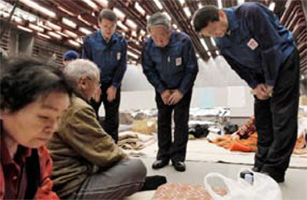
The news from Japan continues to be grim. While the world’s attention remains fixed on the catastrophe at the Fukushima Daiichi nuclear plant and on the brave efforts to stop radiation from leaking into the air, sea and land, the toll from the March 11 earthquake and tsunami continues to rise. As I write this column, the official count is 11,232 dead and 16,361 missing, making the disaster the worst natural calamity that a rich nation has suffered in many years.
In much commentary since the earthquake hit, a comparison has been drawn between the resilience and mutual assistance of the Japanese people and the failings of Japanese public authorities. Prime Minister Naoto Kan has been dismissed as an ineffectual bumbler, and there have been tales of red tape snaring the import of needed supplies and their transportation to the Tohoku region. Certainly, officials of Tokyo Electric Power Co. did not cover themselves with glory in the early days of the crisis by issuing only vague assurances that they were doing their best. It has been easy to slip into the standard line on Japan — that nearly 20 years after the bubble economy burst, it is a mired and stagnant society, one whose leadership has failed its people.
I love Japan. I’ve been a regular visitor there for more than 20 years — I keep thinking of a delightful weekend spent in the green hills of Fukushima prefecture a few years ago — and I am lucky enough to be able to count many Japanese among my friends. But the crude argument that the leaders have failed those wonderful people needs a degree of nuance.
First, it is worth remembering just how devastating the disaster was. There are now reports that the worst tsunami on March 11 topped 13 m. That is almost unbelievably huge. I was in Thailand at the time of the 2004 Boxing Day tsunami, and I saw the damage a tsunami could do — but in Thailand, the waves never got much above 3-4 m . Coping with something of the magnitude that Japan had to deal with would have taxed any nation, no matter how prepared it thought it was.
Second, I’m not ready to give up on Kan. Prime Minister only since June 2010, he made his name in the 1990s by challenging the dead hand of officialdom in the Health Ministry instead of merely navigating the backrooms where bureaucrats, Japan’s permanent politicians in the Liberal Democratic Party and captains of industry scratch one another’s backs. He knows what Japan must do; I have myself heard him speak eloquently of the need for Japan to open itself up to the outside world and provide the safety net that might enable women to re-enter the workforce after they have had children — both vital if Japan is to get moving again.
In that context, I was struck by a recent article by Karel van Wolferen of the University of Amsterdam, for years a perceptive observer of Japanese affairs. The efforts of Kan’s government, van Wolferen argued, are being “obviously hampered by a rigid and much fragmented bureaucratic infrastructure.”
That gets us to the nub of the matter. It is not a leader or two who has let Japan down. The problem has been an establishment of interlocking power bases: civil servants; LDP bigwigs; judges, lawyers and prosecutors; protected economic interests; and, not least, a press whose members, to quote van Wolferen again, are “the world’s greatest connoisseurs of political factionalism … almost incapable of recognizing actual policy initiatives when they see them.”
It follows that the question facing Japan is not whether to trade a few old “leaders” for a few new ones and hope they look better on TV. It is whether a society as a whole can renew itself, moving on many fronts at the same time — economic, cultural, political, official — and handing the levers of social change to those who have been marginalized in the past: women, the young, even immigrants.